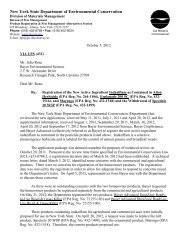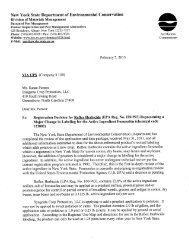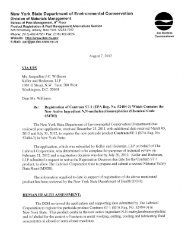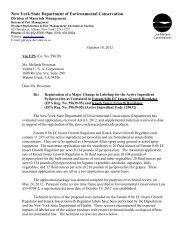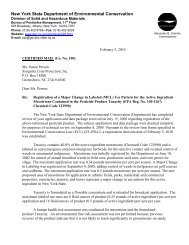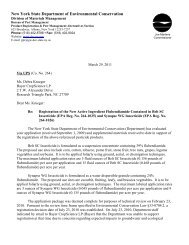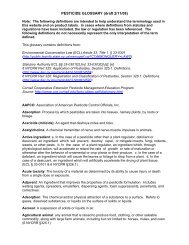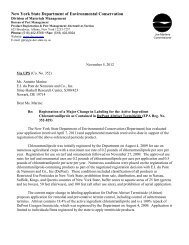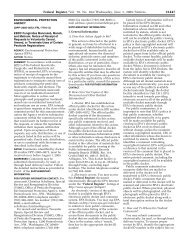Coumaphos/CheckMite Product Label
Coumaphos/CheckMite Product Label
Coumaphos/CheckMite Product Label
Create successful ePaper yourself
Turn your PDF publications into a flip-book with our unique Google optimized e-Paper software.
For Use Only Under Section 18 Authorization<br />
For Control of Varroa Mites and Small Hive Beetles in Honeybee Colonies<br />
For use only as authorized in NEW YORK by the U.S. Environmental Protection Agency<br />
(EPA) under section 18 of F.I.F.R.A. This labeling must be in the possession of the user at the<br />
time of application. This labeling expires February 1, 2003.<br />
Percent<br />
by Weight<br />
Active Ingredient:<br />
0,0-Diethyl 0-(3-chloro-4-methyl-2-oxo-2H-1-benzopyran-7-yl)<br />
phosphorothioate (coumaphos) . . . . . . . . . . . . . . . . . . 10%<br />
Inert Ingredients: . . . . . . . . . . . . . . . . . . . . . . . . . 90%<br />
Total . . . . . . . . . . . . . . . . . . . . . . . . . . . . . . . . 100%<br />
KEEP OUT OF REACH OF CHILDREN<br />
WARNING<br />
SEE LABELING FOR STATEMENTS OF PRACTICAL TREATMENT<br />
AND OTHER PRECAUTIONARY STATEMENTS<br />
NET CONTENTS: (10 Strips)<br />
Bayer Corporation<br />
Agriculture Division<br />
Animal Health<br />
P.O. Box 390<br />
Shawnee Mission, Kansas 66201 U.S.A.<br />
EPA Est. No. 4691-KS-1<br />
x:moiij/labelspr/2002/NewYork2002.doc Page 1 of 4 01/22/02
PRECAUTIONARY STATEMENTS<br />
HAZARDS TO HUMANS AND DOMESTIC ANIMALS<br />
WARNING<br />
Do not chew or swallow. Causes moderate eye irritation. Avoid contact with skin, clothing or<br />
eyes. Wash thoroughly with soap and warm water after handling. Wash contaminated clothing<br />
with soap and hot water before use.<br />
STATEMENTS OF PRACTICAL TREATMENT<br />
If chewed or swallowed: Call a physician or Poison Control Center immediately. If possible,<br />
vomiting should be induced under medical supervision. Drink one or two glasses of water and<br />
induce vomiting by touching the back of throat with finger. Do not induce vomiting or give<br />
anything by mouth to an unconscious person.<br />
If on skin: Remove contaminated clothing and wash affected areas with soap and water. Get<br />
medical attention if irritation appears.<br />
If in eyes: Flush eyes with plenty of water. Call a physician immediately.<br />
To Physician: Atropine sulfate by injection is antidotal. Repeat as necessary to the point<br />
of tolerance. 2-PAM is also antidotal and may be administered in conjunction with atropine.<br />
ENVIRONMENTAL HAZARDS<br />
This pesticide is toxic to birds, fish and aquatic invertebrates. Do not apply directly to any body<br />
of water. Do not contaminate water when disposing of used strips.<br />
x:moiij/labelspr/2002/NewYork2002.doc Page 2 of 4 01/22/02
Directions for Use<br />
It is a violation of Federal law to use this product in a manner inconsistent with its label.<br />
Treatments must be applied at a time when bees are not producing a surplus honey<br />
crop. Chemical resistant gloves (such as waterproof material) must be worn when<br />
handling the strips. Just before application, remove the required number of <strong>CheckMite</strong>+<br />
Strips from the pouch. Unused strips should remain in original package.<br />
Do not treat more than twice a year for varroa mites nor more than four times a year for the<br />
small hive beetle.<br />
For Varroa Treatment - To control varroa mite, remove honey supers before application of<br />
<strong>CheckMite</strong>+ Strips and do not replace until 14 days after the strips are removed. Use<br />
one strip for each five combs of bees in each brood chamber (Langstroth deep frames or<br />
equivalent in other sizes). Hang the strips in separate spaces between the combs as near the<br />
center of the bee/brood cluster as possible. If two deep brood chambers are used for the<br />
brood nest, hang the <strong>CheckMite</strong>+ Strips in both the top and bottom brood chambers. Treat all<br />
infested colonies within the yard. The treatment is most effective when brood rearing is lowest.<br />
Effective control may be achieved by treating hives in the spring before the first honey flow and<br />
in the fall after the last honey flow. For maximum efficacy leave the strips in the hive for at least<br />
42 days (six weeks). Do not leave the strips in hive for more than 45 days. Do not treat<br />
more than twice a year for varroa mites. Honey supers may be replaced 14 days after<br />
the strips are removed.<br />
For Small Hive Beetle Treatment : To control the small hive beetle, remove honey supers<br />
before the application of <strong>CheckMite</strong>+ Strips and do not replace until 14 days after the<br />
strips are removed. Prepare a piece of corrugated cardboard approximately 4x4 inches by<br />
removing one side. Remove one <strong>CheckMite</strong>+ Strip. Cut strip in half crossways and staple the<br />
two pieces to the corrugated side of the cardboard. Tape over the smooth side of the<br />
cardboard (the side opposite the strips) with duct tape, shipping tape or similar tape to prevent<br />
the bees from chewing and removing the cardboard. Or use one sided plastic corrugated<br />
sheets. Place cardboard as near the center of the bottom board as possible with the strips<br />
down. Make sure the bottom board is clean and the strips lay flat on the bottom board. For<br />
maximum efficacy leave the strips in the hive for at least 42 days (six weeks). Do not leave<br />
the strips in hive for more than 45 days. Do not treat more than four times per year<br />
for the small hive beetle. Honey supers may be replaced 14 days after the strips are<br />
removed.<br />
x:moiij/labelspr/2002/NewYork2002.doc Page 3 of 4 01/22/02
Storage & Disposal: Do not contaminate water, food or feed by storage or disposal. Keep<br />
the strips in original, unopened package until ready to use. Do not store in direct sunlight. Do<br />
not store unused strips in anything but original package. Do not store unused strips near<br />
pesticides or other chemical substances that could contaminate the strips and result in bee<br />
toxicity. Do not reuse the strips. Securely wrap the strips and/or container packaging in several<br />
layers of newspapers and dispose in a sanitary land fill.<br />
LIMITED WARRANTY AND<br />
LIMITATION OF DAMAGES<br />
Bayer Corporation, Agriculture Division, Animal Health warrants that this material conforms to<br />
the chemical description on the label. BAYER CORPORATION MAKES NO OTHER<br />
EXPRESS OR IMPLIED WARRANTY, INCLUDING ANY OTHER EXPRESS OR<br />
IMPLIED WARRANTY OF FITNESS OR MERCHANTABILITY, and no agent of Bayer<br />
Corporation is authorized to do so except in writing with a specific reference to this warranty.<br />
Any damages arising from a breach of this warranty shall be limited to direct damages and shall<br />
not include consequential commercial damages such as loss of profits or values, etc.<br />
x:moiij/labelspr/2002/NewYork2002.doc Page 4 of 4 01/22/02



